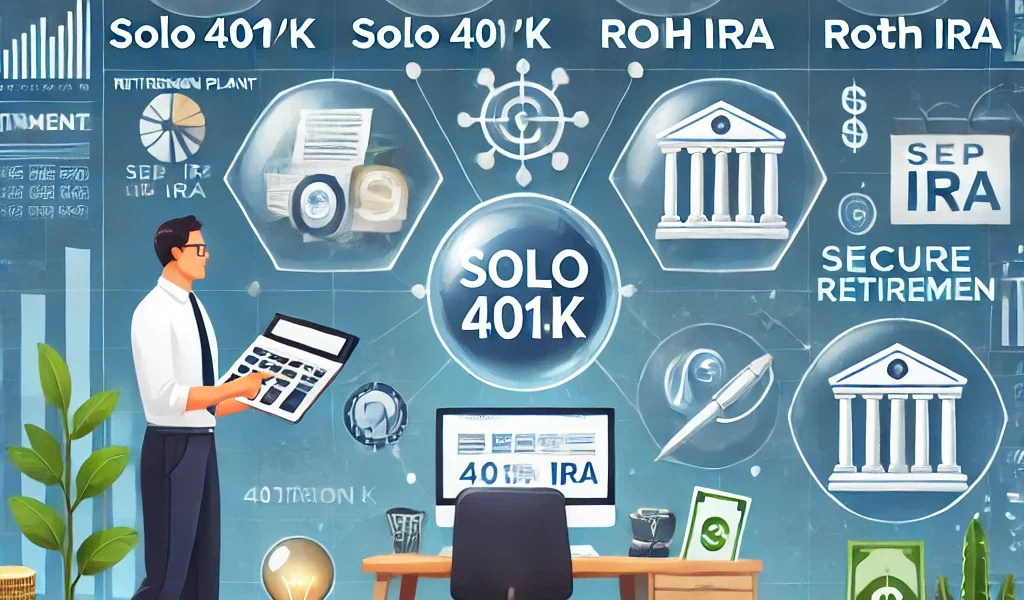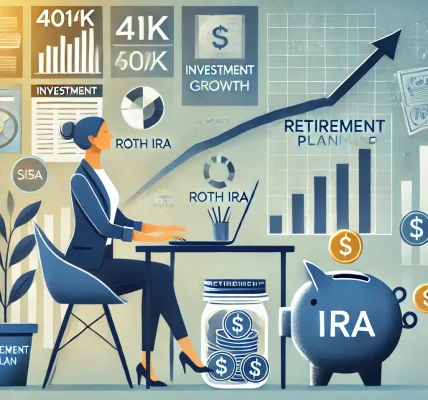Introduction
Planning for retirement is essential for everyone, but for self-employed individuals, it requires extra effort. Unlike traditional employees, self-employed professionals do not receive employer-sponsored retirement benefits, which means they must actively plan and invest for their future.
The good news is that several retirement plans are specifically designed for self-employed individuals, offering tax advantages, flexibility, and growth potential.
In this guide, we’ll explore the best retirement plans for self-employed professionals, their benefits, and how to choose the right one based on your financial goals.
Why Retirement Planning is Crucial for Self-Employed Individuals
As a self-employed professional, you have:
✔ No employer-sponsored 401(k) or pension plan.
✔ No automatic paycheck deductions for retirement savings.
✔ Complete control over your investment strategy.
✔ The ability to choose flexible and high-return options.
Without a proper retirement plan, you may face financial struggles in later years. That’s why starting early and choosing the right plan is crucial.
Best Retirement Plans for Self-Employed Individuals
1. Solo 401(k) Plan
A Solo 401(k) (also known as an Individual 401(k)) is one of the best retirement plans for self-employed individuals. It allows high contribution limits, tax advantages, and flexible investment options.
✔ Who Can Use It?
- Self-employed individuals with no employees (except a spouse).
✔ Key Benefits
✅ High contribution limits ($69,000 in 2024 or $76,500 if aged 50+).
✅ Both employer & employee contributions allowed.
✅ Choose between Traditional (tax-deferred) or Roth (tax-free withdrawals).
✅ Invest in stocks, bonds, mutual funds, real estate, and more.
✔ Drawbacks
❌ Requires more paperwork and reporting compared to IRAs.
❌ Strict IRS rules on contributions and distributions.
2. SEP IRA (Simplified Employee Pension IRA)
A SEP IRA is a simpler alternative to a Solo 401(k), offering easy setup and high contribution limits.
✔ Who Can Use It?
- Any self-employed person or small business owner (even with a few employees).
✔ Key Benefits
✅ Contribute up to 25% of net earnings (max $69,000 in 2024).
✅ Easy to set up and maintain (fewer IRS reporting requirements).
✅ Tax-deductible contributions reduce taxable income.
✅ No required annual contributions (flexible for fluctuating income).
✔ Drawbacks
❌ Only employer contributions are allowed (employees can’t contribute).
❌ No Roth (after-tax) option—withdrawals are taxed.
3. SIMPLE IRA (Savings Incentive Match Plan for Employees)
A SIMPLE IRA is an ideal option if you are self-employed and have a small business with employees.
✔ Who Can Use It?
- Self-employed individuals and small businesses with up to 100 employees.
✔ Key Benefits
✅ Lower contribution limits but easy to set up.
✅ Employees can contribute, and employers must match contributions.
✅ Employer contributions are tax-deductible.
✔ Drawbacks
❌ Contribution limits are lower than Solo 401(k) or SEP IRA.
❌ Employers must contribute each year, even if business profits decline.
4. Roth IRA & Traditional IRA
If you’re looking for a flexible and simple retirement plan, a Roth IRA or Traditional IRA is a great option.
✔ Who Can Use It?
- Any self-employed individual with earned income.
✔ Key Benefits
✅ Roth IRA: Tax-free withdrawals in retirement.
✅ Traditional IRA: Tax-deductible contributions lower your taxable income.
✅ Easy to set up with no employer contributions required.
✔ Drawbacks
❌ Lower contribution limits ($7,000 in 2024, or $8,000 if aged 50+).
❌ Income limits apply for Roth IRA contributions.
5. Defined Benefit Plan (Self-Employed Pension Plan)
A Defined Benefit Plan is best for high-income self-employed individuals who want large tax-deferred retirement contributions.
✔ Who Can Use It?
- Self-employed professionals earning a high income (doctors, consultants, etc.).
✔ Key Benefits
✅ Extremely high contribution limits (often $100,000+ per year).
✅ Provides guaranteed retirement income.
✅ Significant tax benefits (reducing taxable income).
✔ Drawbacks
❌ Requires annual contributions, even in low-income years.
❌ Complex setup with high administrative costs.
Comparison of Retirement Plans for Self-Employed Individuals
| Plan Type | Contribution Limit (2024) | Tax Benefit | Best For | Flexibility |
|---|---|---|---|---|
| Solo 401(k) | Up to $69,000 (or $76,500 if 50+) | Pre-tax or Roth | High-income freelancers | High |
| SEP IRA | 25% of income (max $69,000) | Pre-tax | Self-employed with no employees | Medium |
| SIMPLE IRA | Up to $16,000 (+ $3,500 if 50+) | Pre-tax | Small business owners with employees | Medium |
| Roth IRA | Up to $7,000 (+ $8,000 if 50+) | Tax-free withdrawals | Lower-income earners | High |
| Defined Benefit Plan | Varies (often $100,000+) | Pre-tax | High-income professionals | Low |
How to Choose the Right Retirement Plan?
✔ Choose a Solo 401(k) if:
- You have no employees.
- You want high contribution limits and investment flexibility.
✔ Choose a SEP IRA if:
- You have a few employees or want a simple plan.
- You want high tax-deductible contributions.
✔ Choose a SIMPLE IRA if:
- You run a small business with employees.
- You need a cost-effective retirement plan.
✔ Choose a Roth IRA if:
- You expect your tax rate to be higher in retirement.
- You want tax-free withdrawals.
✔ Choose a Defined Benefit Plan if:
- You earn a high income and want big tax deductions.
- You need a guaranteed pension-like retirement income.
Final Thoughts
Retirement planning is critical for self-employed professionals, and choosing the right plan can maximize tax savings, flexibility, and investment growth.
📌 If you’re just starting, a Roth IRA or SEP IRA may be a great option.
📌 If you earn a high income, a Solo 401(k) or Defined Benefit Plan can provide maximum tax benefits.
📌 If you have employees, consider a SIMPLE IRA for easy setup.




